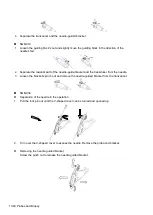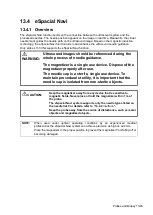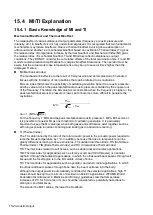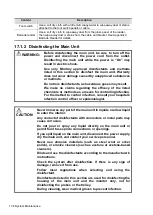
Acoustic Output 15-1
15
Acoustic Output
This section of the operator’s manual applies to the overall system, including the main unit, probes,
accessories and peripherals. This section contains important safety information for device
operators pertaining to acoustic output and how to control patient exposure through use of the
ALARA (as low as reasonably achievable) principle. This section also contains information
regarding acoustic output testing and real-time output display.
Read this information carefully before using the system.
15.1 Concerns with Bioeffects
Diagnostic ultrasound is recognized as being safe. There have been no reports of injuries to
patients caused by diagnostic ultrasound.
However, it cannot be stated categorically that ultrasound is 100% safe. Studies have revealed
that ultrasound with extremely high intensity is harmful to body tissues.
Diagnostic ultrasound technology has made a great leap forward during the last several years.
This rapid advance has generated concerns about the potential risk of bioeffects when new
applications or diagnostic technologies become available.
15.2 Prudent Use Statement
Although there are no confirmed biological effects on patients caused by exposure from present
diagnostic ultrasound instruments, the possibility exists that such biological effects may be
identified in the future. Thus ultrasound should be used in a prudent manner to provide medical
benefit to the patient. High exposure levels and long exposure times should be avoided while
acquiring the necessary clinical information.
15.3 ALARA Principle (As Low As Reasonably
Achievable)
The ALARA principle must be practiced when using ultrasound energy. Practicing ALARA ensures
that the total energy level is controlled below a low enough level at which bioeffects are not
generated while diagnostic information is being accumulated. The total energy is controlled by
output intensity and total radiation time. The output intensity necessary for examinations differs
depending on the patient and the clinical case.
Not all examinations can be performed with an extremely low level of acoustic energy. Controlling
the acoustic level at an extremely low level leads to low-quality images or insufficient Doppler
signals, adversely affecting the reliability of the diagnosis. However, increasing the acoustic power
more than necessary does not always contribute to an increase in the quality of the information
required for diagnosis, rather increasing the risk of generating bioeffects.
Users must take responsibility for the safety of patients and utilize ultrasound deliberately.
Deliberate use of ultrasound means that the output power of ultrasound must be selected based
on the ALARA principle.
Additional information regarding the concept of ALARA and the possible bioeffects of ultrasound is
available in a document from the AIUM (American Institute of Ultrasound Medicine) entitled
“Medical Ultrasound Safety.”
Summary of Contents for TE5
Page 1: ...TE7 TE5 Diagnostic Ultrasound System Operator s Manual Basic Volume ...
Page 2: ......
Page 6: ......
Page 12: ......
Page 24: ......
Page 36: ......
Page 54: ......
Page 110: ......
Page 115: ...Display Cine Review 6 5 6 Tap Return on the screen or tap Freeze to exit image compare ...
Page 120: ......
Page 124: ......
Page 156: ......
Page 174: ......
Page 192: ...12 18 Setup Select Advanced and do as follows Select MAPS and do as follows ...
Page 202: ...13 2 Probes and Biopsy C5 2s L12 4s L7 3s P4 2s L14 6s C11 3s L14 6Ns V11 3Ws P7 3Ts 7LT4s ...
Page 226: ...13 26 Probes and Biopsy NGB 034 NGB 035 ...
Page 250: ......
Page 272: ......
Page 276: ...A 4 Wireless LAN Tap Add Manually create a network profile to set ...
Page 282: ......
Page 318: ......
Page 322: ......
Page 323: ...P N 046 006959 07 1 0 ...
















































